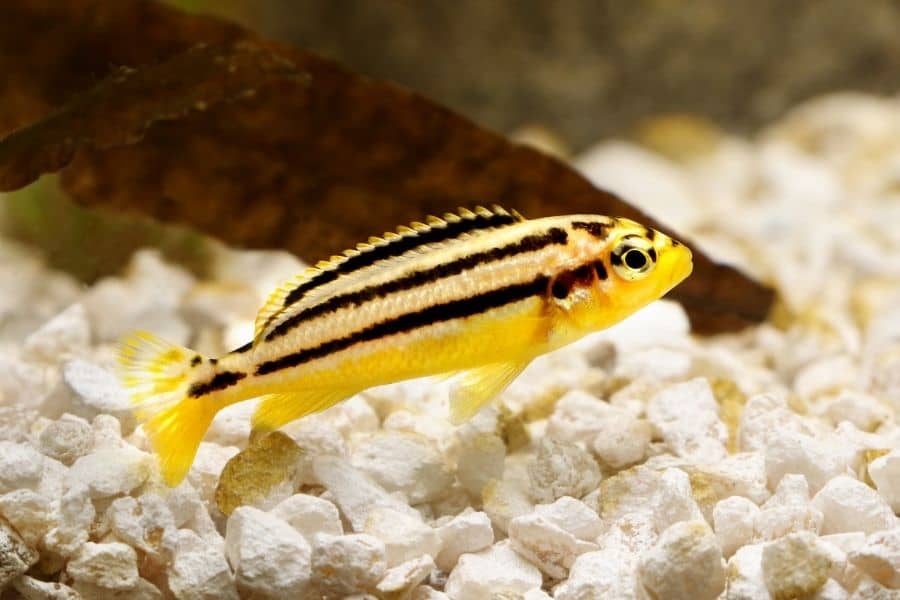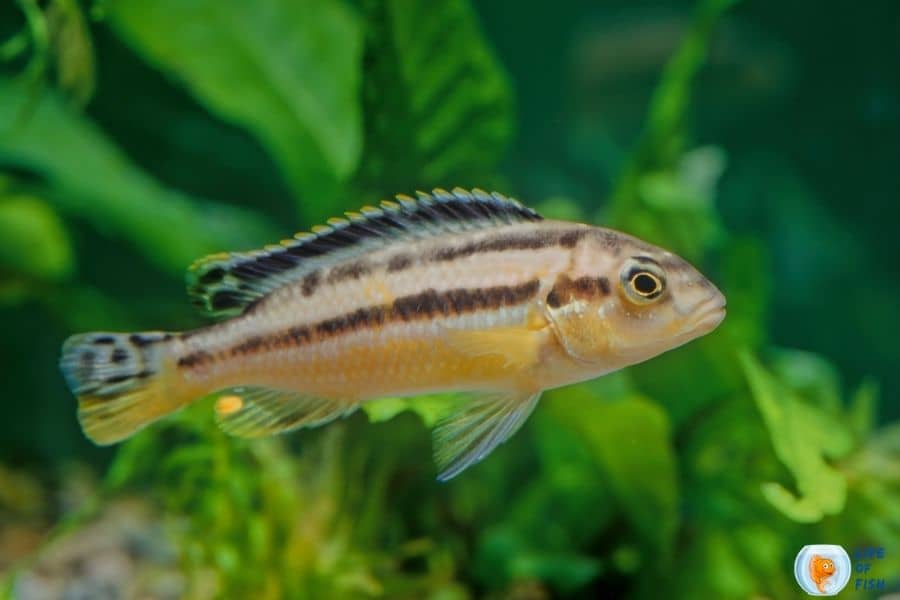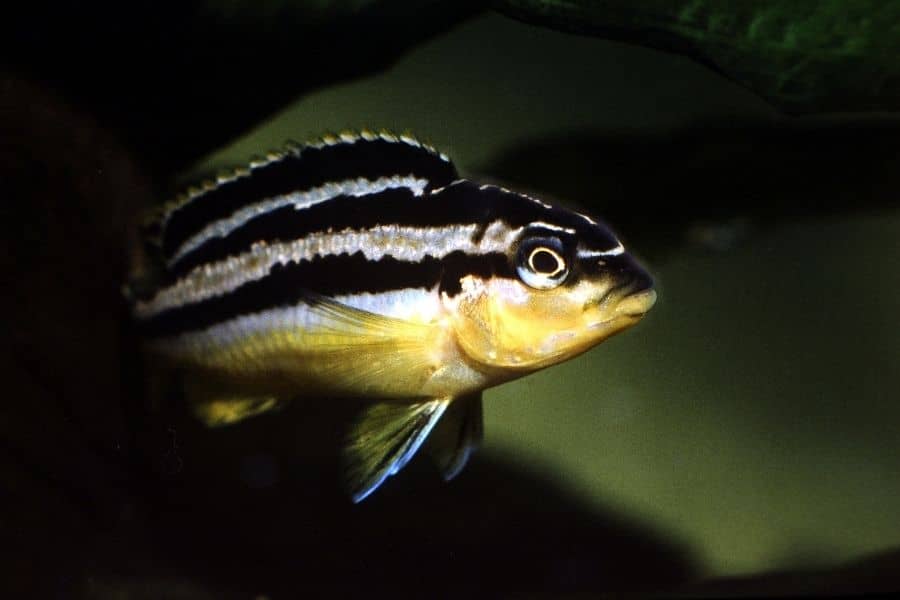Auratus cichlid is a true beauty among Mbuna cichlids, but it is one of the most aggressive cichlid species available in the aquarium trade. Actually, they can terrorize fish that are twice their size.
This makes them unsuitable for beginner aquarists because they can not be kept with fish of similar size. It’s hard to maintain a suitable population because usually, one or two individuals will cause a lot of stress and damage all other fish in the tank.
This guide will go through everything you need to know about Auratus Cichlid care.

What is auratus cichlid?
Jump To
- 1 What is auratus cichlid?
- 2 How big do auratus cichlid get?
- 3 Is auratus cichlid aggressive?
- 4 Auratus cichlid behavior
- 5 How long do auratus cichlids live?
- 6 One look care guide
- 7 Auratus cichlid care
- 8 Auratus cichlid breeding
- 9 Special tips
- 10 How to feed auratus cichlid?
- 11 What fish can live with auratus cichlid?
- 12 Related questions
Auratus cichlid (Melanochromis auratus), also known as Golden Cichlid, Golden Mbuna, Malawi Golden Cichlid, or African Golden Mbuna, is a Mbuna cichlid species native to Lake Malawi in Africa.
Its natural habitat includes the rocky shore areas of Lake Malawi, where it is found in areas with sandy or pebble bottoms.
The adult auratus cichlid is yellow-gold with three black horizontal stripes. The caudal and dorsal fins show blue spots of varying sizes.
Males are slightly larger than females, with spots on the anal fin, reverse color morph, and three egg spots (ocellus) on their anal fin.
Females have a bright yellow coloration on the belly, making them easily distinguishable from males.
These fish are among the first cichlids introduced to the aquarium trade and are considered moderately difficult to care for because of their aggression.
How big do auratus cichlid get?
Auratus cichlid is a small-sized fish that can grow up to 4 inches (11 cm) in length. Although they are small, they can not live well even with large-sized tank mates.
Is auratus cichlid aggressive?
Auratus cichlid is a highly aggressive cichlid that can not be kept with fish of similar size.
They are very territorial and will establish their territory in the tank, attacking any tank mates that come into their territory.
Many novice aquarists bring these fish into their community tanks to find them killing the other fish in the tank.
They are notable for attacking other fish that are many times larger than themselves, which is quite unusual in the fish world.
Their aggressive behavior is related to the fact that they are predatory fish and should be kept in a tank with plenty of caves and hiding spots.
Auratus cichlid behavior
Auratus cichlids are shoaling fish that prefer to stay in 8 to 10 fish groups. However, the female population should be more to keep the peace among them.
If they do not get adequate space, males will fight each other until death. In a spacious tank, they can spawn and breed successfully.
These fish are very territorial and will establish their territory in the tank, attacking any fish entering their territory.
Many novice aquarists bring these fish into their community tanks to find them killing the other fish in the tank.
They are notable for attacking other fish that are many times larger than themselves, which is quite unusual in the fish world.
Despite the fact they are aggressive, these fish are omnivore fish and prefer to eat plant-based food than hunting.

How long do auratus cichlids live?
Generally, Auratus cichlids live from 5 to 8 years when they are in the wild, but it’s unlikely that you’ll have your fish long enough to see its complete life cycle since they are prone to catching diseases or getting bullied by other fish in the tank.
One look care guide
| Scientific name | Melanochromis auratus |
| Common name | Auratus cichlid Golden Cichlid Golden Mbuna Malawi Golden Cichlid African Golden Mbuna |
| Care level | Moderately difficult |
| Native to | Lake Malawi in Africa |
| Type | Freshwater fish |
| Color | yellow-gold with three black horizontal stripes |
| Tank size | 50 gallons minimum 125 gallons optimum |
| Preferred temperature | 75.0 to 77.0° F (23.9 to 25.0° C) |
| Other water parameters | pH: 7.7 to 8.6 Hardness: 6 to 10 dGH |
| Preferred salinity | Under 1.0002 ppm |
| Size | 4 inches |
| Life span | Five years |
| Temperament | Very aggressive |
| Recommended tank mates | Do best in a species only tank Maylandia lombardoi Pseudotropheus demasoni Bristlenose pleco Multipunctatus catfish (cuckoo catfish) Petricola cat |
| Preferred food | Plant-based food Pellets Flakes live and frozen food |
| Feeding frequency | Two times per day |
| Breeding | Easy, egg-laying mouthbrooders |
Auratus cichlid care
Auratus cichlids are hardy and easy to care for if you know how to manage their aggressive behavior.
As these fish are highly aggressive and territorial, they are not recommended for community tanks.
But if you still want to keep them in a tank with other fish, make sure there are plenty of caves and hiding spots and have compatible tank mates.
Auratus cichlid size
It is a small-sized fish that can grow up to 4 inches (11 cm) in length.
Auratus cichlid tank size
Regardless of their small size, these fish require a larger tank of at least 50 gallons to give them enough space for territories. 125 gallons will be the bare minimum size if you plan to keep other fish.
How many auratus cichlids should be kept together?
You can keep up to 8 Auratus cichlids in a 50-gallon tank. However, the tank must have only one male with several females.
If you want to keep more males, you’ll have to go with a 125-gallon tank to reduce aggression. Otherwise, you can end up with dead fish.

Tank setup
Since Auratus cichlids are rock-dwelling fish, they need a rockscape in their tank. You can use artificial rocks and real ones to make the aquarium look natural.
Substrate
Auratus cichlids require alkaline water in their habitats. You can promote alkalinity by using crushed coral as the substrate. However, if you have other plans to increase pH levels, you can use either sand or gravel as the substrate.
Decorations and plants
Auratus cichlids do not do well with plants. They tend to uproot plants all the time. So, it is wise not to add any plants in an Auratus cichlid tank.
The decorative items of an Auratus cichlid tank should be rocks and caves. They can provide hiding spots and look natural in the tank.
Filtration and water current
Lighting
These fish will do well in moderate to standard lighting. You can use either fluorescent or LED lighting.
Water quality condition
Auratus cichlids’ natural habitat is known to have high mineral content. That’s why you need to maintain a high pH level in your tank.
The recommended pH level is 7.7 to 8.6, while the hardness should be about 6 to 10 dGH.
Since Lake Malawi is situated in a temperate climate, these fish expect a hot temperature in their habitats. The water temperature should be around 73.0 to 82.0° F (22.8 to 27.8° C).
Although Auratus cichlids are freshwater fish, they have a slight tolerance to salt. Therefore, you can keep these fish in slightly brackish water conditions.
However, the salinity should be under 1.0002ppm. Most aquarists decide to add salt to increase water’s carbonate hardness and soften the water.

Auratus cichlid breeding
Auratus cichlids are easy to breed if given plenty of space.
The best breeding conditions are the tanks with pH levels between 6.0 to 7.0, a hardness level of 4 to 6 dGH, and a temperature of 75.0 to 77.0° F (23.9 to 25.0° C).
Auratus cichlid male or female identification (auratus cichlid male vs female)
Auratus cichlids show sexual dimorphism, which means males and females have opposite coloring.
Juveniles and females have a golden-colored belly with black and white stripes on the part of the body.
On the other hand, Males have the reverse pattern; a black or brown body with light blue or yellow stripes.
If the fish has more yellow coloration, it is a female. If the fish is darker in color, it is a male.
However, when there are no males for the company, the dominant female tends to change its color to appear as males. But the sex of the dominant female will not change.
When spawning, the male changes its color to more intense, vivid colors. It also has a slimmer appearance, and its fins have been reduced in size.
Identify pregnant auratus cichlid and auratus cichlid pregnancy stages
Once the female is ready to breed, it will become plumper in appearance. Its belly will also have a pink color to it.
After the breeding, the female will give birth to anywhere between 10 to 40 eggs. The female then immediately takes them to the mouth.
Then the male discharges sperm (milts) on the eggs. Afterward, the female will keep the eggs in her mouth for around 21 days before releasing the free-swimming fry.
Auratus cichlid breeding
Like any other cichlid species, Auratus cichlids are also easy to breed in captivity. They are polygamous in nature, which means one male attends several females to form a matriarchal family.
These fish take about 6 to 9 months to sexually mature and start breeding a few months later. These fish spawn on their own when the conditions are favorable. No conditioning is needed.
When the fish are ready to spawn, the male builds a nest by digging the sand in his territory. The male becomes more aggressive and chases away any fish except females from the nest area.
Once the female comes near the nest, the male starts circling the female, and female fish then lay the eggs.
Auratus cichlids are egg-laying mouthbrooders. The female protects the eggs and fries in its mouth until the fry becomes free-swimming.
Once the female releases her fry, she is ready to spawn again. This species is not a good choice for those who want to raise cichlids fry.
How many babies do auratus cichlid have?
Auratus cichlid females will lay about 10 to 40 eggs at a time, depending on the size and age of the female. Therefore, we can expect around 5 to 30 fish fry after successful spawning.
Auratus cichlid fry care
The small baby Auratus cichlids will be on their own after 21 days, but the parents will continue to protect their territory for a few weeks.
Once the female fish releases the fry from her mouth, you can start to feed the fry. The fry should be raised in their own grow-out tank, if possible.

Special tips
Poor water conditions will cause these fish to get stressed and become unhealthy. You can easily identify sick fish by checking their behavior.
A stressed-out or ill fish will lose its appetite, and it will gasp for air at the water surface. If these signs are seen in your fish, you should immediately find the cause and remedy it.
If you keep Auratus cichlids for long, you can add some salt to the water. The Auratus cichlid will be healthier with a small amount of salt in their water. However, do not add salt when the fry is just born.
How to feed auratus cichlid?
Auratus cichlids are omnivore fish but have a herbivore diet in nature. They eat any plant or algae they find around them, which is why you should avoid adding plants to your tank.
These fish eat plants and algae in the wild when their stomach is empty. On the other hand, they eat meaty food when they are well fed.
These fish will eat just about anything you feed them in captivity. You can give them sinking pellet foods or flake food.
They will also eat fresh and frozen foods that are rich in plant matters several times a day.
You can also feed them meaty food like Spirulina, blood worms, and brine shrimps but avoid feeding them foods like a beef heart as they cause digestive problems in fish.
The fish will readily eat sinking food. Mix powdered or liquid vitamins in their food to ensure your auratus cichlids have a balanced diet.
What fish can live with auratus cichlid?
Auratus cichlids are not good community fish. They do better in a species only tank. These fish are aggressive with other fish that are not their species.
They can also be aggressive towards fish of the same species, especially during breeding. They may also become aggressive towards other fish in your tank if their territory is invaded.
Auratus cichlids also become aggressive toward fish that look like Auratus cichlid males. Therefore, you should avoid similar-looking fish at all costs.
They do not do well with other cichlid species either. Some cichlids won’t even spawn until you remove these cichlids from the tank.
Because of their aggressive behavior, Auratus cichlids will do fine with other aggressive fish with the same sized and bottom-dwelling fish.
The best tankmates are maylandia lombardoi, pseudotropheus demasoni, bristlenose pleco multipuncatus catfish (cuckoo catfish), and petricola cat. Still, mixing these fish with other fish species is a big no-no.
Related questions
Are auratus cichlids rare?
Auratus cichlids are not rare because they are easy to breed in captivity. However, they are not on the cheap side because of their beauty.
You have to pay around $20 to $40 for a pair of auratus cichlid. They are readily available in the fish stores, but you might not find them often because of their price.
Are auratus cichlids mouthbrooders?
Yes. Auratus cichlids are mouthbrooders. Females hold eggs and fry in their mouth until they are ready to swim with the fry outside the mouth.
Read Next : Chili Rasbora | How I Keep Them Healthier!
